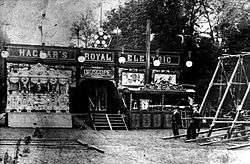Bioscope show
A Bioscope show was a music hall and fairground attraction consisting of a travelling cinema. The heyday of the Bioscope was from the late 1890s until World War I.

Bioscope shows were fronted by the largest fairground organs,[1] and these formed the entire public face of the show. A stage was usually in front of the organ, and dancing girls would entertain the crowds between film shows.[2]
Films shown in the Bioscope were primitive, and the earliest of these were made by the showmen themselves. Later, films were commercially produced.
Bioscope shows were integrated, in Britain at least, into the Variety shows in the huge Music Halls which were built at the end of the nineteenth century.
After the Music Hall Strike of 1907 in London, bioscope operators set up a trade union to represent them. There were about seventy operators in London at this point.
Modern use
In South Africa "Bioscope" or in Afrikaans "bioskoop" is an archaic word for the cinema and some people (especially older generations) still use it regularly.
In modern day Dutch, "bioscoop" is a wide-spread term, and the equivalent of the English "movie theater" or "cinema".
In Serbian language, "bioskop" is a modern term for movie theater.
References
- "Hollycombe Steam Museum bioscope show"
- "Fairground Heritage Trust" Archived July 3, 2011, at the Wayback Machine